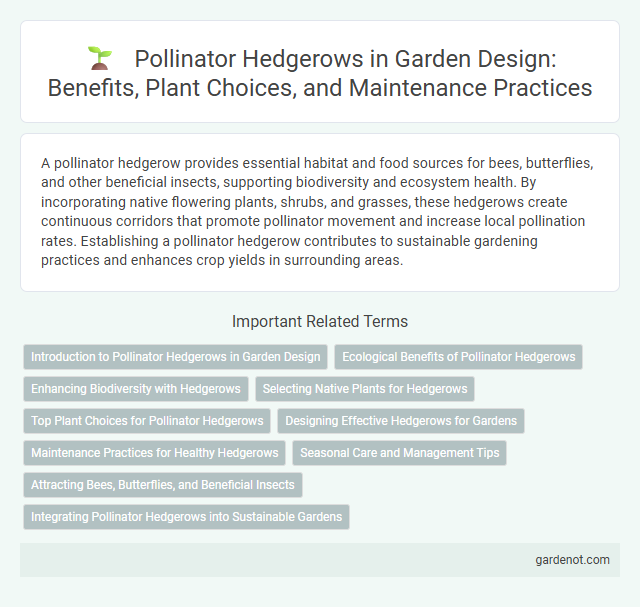A pollinator hedgerow provides essential habitat and food sources for bees, butterflies, and other beneficial insects, supporting biodiversity and ecosystem health. By incorporating native flowering plants, shrubs, and grasses, these hedgerows create continuous corridors that promote pollinator movement and increase local pollination rates. Establishing a pollinator hedgerow contributes to sustainable gardening practices and enhances crop yields in surrounding areas.
Introduction to Pollinator Hedgerows in Garden Design
Pollinator hedgerows in garden design serve as vital biodiversity corridors that support native pollinators such as bees, butterflies, and hummingbirds by providing continuous forage and shelter. Incorporating a mix of native flowering shrubs, grasses, and perennials creates seasonal blooms that sustain pollinators throughout the year while enhancing garden resilience. These hedgerows not only boost pollination rates for nearby plants but also improve ecosystem health by promoting natural pest control and soil stability.
Ecological Benefits of Pollinator Hedgerows
Pollinator hedgerows enhance biodiversity by providing continuous habitats and food sources for bees, butterflies, and other essential pollinators, supporting ecosystem stability and resilience. These hedgerows contribute to improved pollination services for adjacent crops, directly increasing agricultural productivity and food security. By reducing soil erosion and fostering natural pest control through habitat diversification, pollinator hedgerows promote sustainable land management and ecological balance.
Enhancing Biodiversity with Hedgerows
Pollinator hedgerows provide essential habitats that support diverse species of bees, butterflies, and other pollinators, enhancing local biodiversity. These linear plantings of native flowering shrubs and grasses create crucial foraging corridors and nesting sites, promoting ecosystem health and resilience. Incorporating a mix of bloom times in hedgerows ensures continuous food supply throughout the growing season, increasing pollinator activity and plant reproduction.
Selecting Native Plants for Hedgerows
Selecting native plants for pollinator hedgerows enhances biodiversity and supports local ecosystems by providing essential nectar and pollen sources for bees, butterflies, and other pollinators. Native species such as milkweed, goldenrod, and asters thrive in local soil and climate conditions, ensuring sustainability and low maintenance. Incorporating a variety of flowering plants with staggered bloom times guarantees continuous food availability throughout the growing season.
Top Plant Choices for Pollinator Hedgerows
Top plant choices for pollinator hedgerows include native flowering shrubs such as Ceanothus, Sambucus, and Rhododendron, which provide abundant nectar and pollen. Incorporating perennials like Echinacea, Asclepias, and Salvia enhances habitat diversity and supports a wide range of pollinators including bees, butterflies, and hummingbirds. Selecting plants with staggered bloom times ensures continuous food supply throughout the growing season, boosting pollinator populations and garden biodiversity.
Designing Effective Hedgerows for Gardens
Designing effective pollinator hedgerows involves selecting a diverse mix of native flowering shrubs, perennials, and grasses that provide continuous bloom throughout the growing season. Incorporating plants like milkweed, goldenrod, and serviceberry enhances habitat connectivity and supports a wide range of pollinators including bees, butterflies, and hummingbirds. Proper spacing and layered planting maximize foraging resources and shelter, creating an inviting environment that boosts pollination and overall garden health.
Maintenance Practices for Healthy Hedgerows
Regular pruning and selective trimming are essential maintenance practices for pollinator hedgerows, ensuring optimal sunlight penetration and airflow that promote plant health. Incorporating organic mulching helps retain soil moisture and suppresses weeds, reducing competition for nutrients vital to pollinator-attracting flora. Monitoring for pests and diseases allows early intervention, preserving the biodiversity crucial for sustaining pollinator populations within the hedgerow ecosystem.
Seasonal Care and Management Tips
Pollinator hedgerows require seasonal care to maintain plant health and support diverse pollinators year-round. In spring, pruning and removing dead growth encourage new blooms, while summer watering ensures flower vitality during dry periods. Fall management includes mulching and planting native perennials to provide shelter and food throughout winter, enhancing pollinator habitat sustainability.
Attracting Bees, Butterflies, and Beneficial Insects
Pollinator hedgerows planted with native flowering species create essential habitats that attract bees, butterflies, and beneficial insects by providing diverse nectar and pollen sources throughout the growing season. Incorporating plants such as milkweed, coneflowers, and goldenrod enhances foraging opportunities and supports the life cycles of pollinators while promoting biodiversity. These hedgerows serve as natural corridors, increasing pollination efficiency in adjacent agricultural or garden areas and improving overall ecosystem health.
Integrating Pollinator Hedgerows into Sustainable Gardens
Pollinator hedgerows enhance sustainable gardens by providing essential habitats for bees, butterflies, and other pollinators, promoting biodiversity and improving crop yields. Native flowering plants and shrubs in hedgerows offer continuous nectar and pollen sources throughout the growing season, supporting pollinator health and population stability. Integrating these hedgerows into garden design reduces the need for chemical inputs by encouraging natural pest control and enhancing ecosystem resilience.
Pollinator hedgerow Infographic

 gardenot.com
gardenot.com